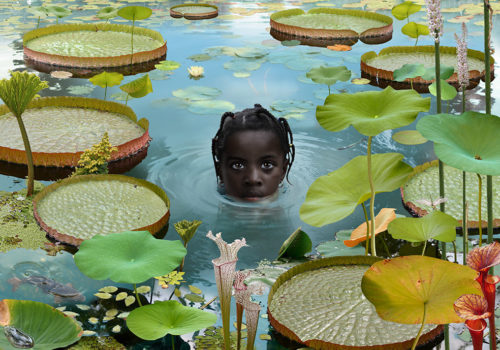The fourth edition of the PORTRAIT(S) festival of Vichy opens its doors . Until September 4th Vichy is an outpost of today’s photography for a season and is presenting to the public some exhibitions centered exclusively around the art of the portrait. This new edition is showing nine artists whose exhibitions are taking place simultaneously in the city centre and its surroundings, in the open air. L’Oeil de la Photographie brings you the work of one photographer from the programme every day. Today, focus on « Il était une fois » by Ruud van Empel.
Once upon a time…
The forest
By around 2003, van Empel had achieved a high degree of perfection with his labour-intensive technique of making photomontages. Although the spectator is aware that a certain image cannot be photographed in a single shot, it remains impossible to discover the ‘making of’. The human figures that van Empel represents (exclusively children from this point onward) look as if they have been taken from real life. The first series in which he reached this magical new unity was Study in Green, a series of forest-scapes. […] Every detail had been photographed at its most favourable and although van Empel does not wish to present a dissonance anywhere in the picture, it is not only comfort-zone artistry. On this subject, Pieter van Leeuwen wrote: ‘We see the best experiences, as it were, of a long walk in the woods in one compressed picture. Despite this euphoric angle of approach, spectators utter totally different sounds. Instead of attractive deciduous woods, they see scary primeval forests in which danger lurks behind every tree.’ At a second glance, the shadows do seem rather deep… Traditionally, the dark forest is regarded as a dangerous place.
This angst reaches back to the time in which people first began to develop agriculture: the open field was cultivated and was familiar and trusted, whereas the surrounding forests formed a disorientating world full of unknown hazards. In the forest, you were outside society, as it were. In depth psychology, the forest is regarded as a symbol for the subconscious, which harbours sinister forces we prefer not to know. […] In fairy tales, woods usually represent a threatening world. […]
In the series that Van Empel made after Study in Green, called Untitled, there is always a little girl somewhere among the trees. Although the woods are now a good bit lighter, with much more slender trees, an alienating discrepancy is invariably tangible in the setting. The pose and dress of the girls calls to mind the photos that parents make of their children in their communion outfit […], but such photos are generally taken in the garden or in a well-laid-out park, not in the depths of the forest where the expensive new clothes could easily become dirty or damaged.
In 2007, the art historian Jan Baptist Bedaux wrote about van Empel’s use of black models: ‘The fact that many of the children in his compositions have a dark skin is a facet that cannot remain without comment. Although it is self-evident that a child’s skin colour is not important, the iconography of the innocent child was traditionally represented by “white” children. […] In deviating from the standard iconography by giving the children a dark skin, Van Empel inadvertently assumes a political stance.
After all, this child is still the focus of discrimination and its innocence is not recognized by everyone as being self-evident. The most pregnant image from this World series is undoubtedly the one of the girl whose black skin contrasts sharply with the dazzling whiteness of her dress.’
[…] Van Empel, who lives and works in multi-coloured Amsterdam and actually wishes to make no distinction at all, is not seeking controversy but, on the other hand, is not out to please. Even with all the beauty and tenderness in his work, there still remains a slightly discomforting element: a ‘different’ significance that lurks just under the surface, a question that remains unanswered […]. The two boys in World#32 are standing arm in arm, as if they were going to be married – or are they perhaps twins?
Some children linger dreamily by a pond, but most of them pose stiffly and hesitantly in clothes that are much too neat for playing and horsing around. Yet other kids stare at us from the water into which they seem to wish to retreat at any moment.
Excerpts from the essay by Ruud Schenk, curator Modern Art, Groninger Museum, The Netherlands
FESTIVAL
PORTRAIT(S)
From June 10th to September 4th, 2016
Il était une fois
Ruud van Empel
Centre Culturel Valery-Larbaud
03200 Vichy
France
https://www.ville-vichy.fr/agenda/festival-portraits-2016
http://web.ruudvanempel.nl
















